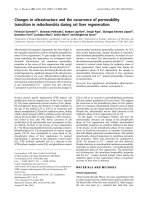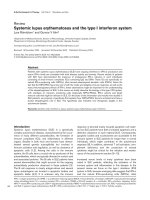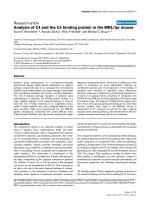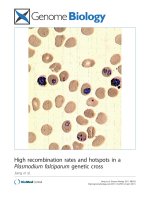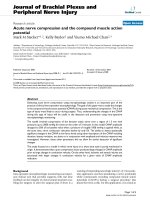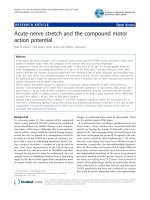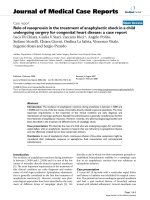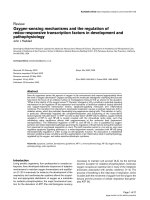Báo cáo y học: "Science Review: Vasopressin and the cardiovascular system part 1 – receptor physiology" doc
Bạn đang xem bản rút gọn của tài liệu. Xem và tải ngay bản đầy đủ của tài liệu tại đây (296.1 KB, 8 trang )
427
ACTH = adrenocorticotropic hormone; DAG = diacylglycerol; DDAVP = 1-deamino-8-D-arginine vasopressin; GPCR = G-protein-coupled recep-
tor; GRK = G protein-coupled receptor kinase; OTR = oxytocin receptor; PKC = protein kinase C; P
2
R = P
2
purinergic receptors; V
1
R = V
1
vascu-
lar receptor; V
2
R = V
2
renal receptor; V
3
R = V
3
pituitary receptor.
Available online />Introduction
Arginine vasopressin (hereafter referred to as vasopressin),
also known as antidiuretic hormone, is essential for survival,
as attested by its teleologic persistence. Oxytocin- and vaso-
pressin-like peptides have been isolated from four inverte-
brate phyla and the seven major vertebrate families,
representing more than 120 species [1]. Therefore, the
ancestral gene encoding the precursor protein appears to
antedate the divergence of the vertebrate and invertebrate
families, about 700 million years ago [2]. Virtually all verte-
brate species possess an oxytocin-like and a vasopressin-like
peptide, and so two evolutionary lineages can be traced. The
presence of a single peptide, vasotocin ([Ile3]-vasopressin or
[Arg8]-oxytocin), in the most primitive cyclostomata supports
the notion that primordial gene duplication with subsequent
mutations gave rise to the two lineages [2].
Vasopressin is essential for cardiovascular homeostasis. The
vasopressor effect of pituitary extract, first observed in 1895,
was attributed to the posterior lobe of this gland [3]. It was not
until 18 years later that the antidiuretic effect of neurohypophy-
seal extract was demonstrated [4,5]. After isolation and syn-
thesis of vasopressin in the 1950s, it was proven that the
same hormone in the posterior pituitary possessed both anti-
diuretic and vasopressor effects [6,7]. The importance of
vasopressin in osmotic defense is fundamental. Indeed, the
antidiuretic effect of vasopressin has been exploited clinically
for over half a century to treat diabetes insipidus. Only recently
has vasopressin emerged as a therapy for shock states,
renewing interest in the cardiovascular effects of vasopressin.
Shock states induce an increase in vasopressin levels from
20- to 200-fold [8–12]. These supraphysiologic levels cause
Review
Science Review: Vasopressin and the cardiovascular system
part 1 – receptor physiology
Cheryl L Holmes
1
, Donald W Landry
2
and John T Granton
3
1
Staff intensivist, Department of Medicine, Division of Critical Care, Kelowna General Hospital, Kelowna BC, Canada
2
Associate Professor, Department of Medicine, Columbia University, New York, New York, USA
3
Assistant Professor of Medicine, Faculty of Medicine, and Program Director, Critical Care Medicine, University of Toronto, and Consultant in
Pulmonary and Critical Care Medicine, Director Pulmonary Hypertension Program, University Health Network, Toronto, Ontario, Canada
Corresponding author: John T Granton,
Published online: 26 June 2003 Critical Care 2003, 7:427-434 (DOI 10.1186/cc2337)
This article is online at />© 2003 BioMed Central Ltd (Print ISSN 1364-8535; Online ISSN 1466-609X)
Abstract
Vasopressin is emerging as a rational therapy for vasodilatory shock states. Unlike other vasoconstrictor
agents, vasopressin also has vasodilatory properties. The goal of the present review is to explore the
vascular actions of vasopressin. In part 1 of the review we discuss structure, signaling pathways, and
tissue distributions of the classic vasopressin receptors, namely V
1
vascular, V
2
renal, V
3
pituitary and
oxytocin receptors, and the P
2
class of purinoreceptors. Knowledge of the function and distribution of
vasopressin receptors is key to understanding the seemingly contradictory actions of vasopressin on the
vascular system. In part 2 of the review we discuss the effects of vasopressin on vascular smooth
muscle and the heart, and we summarize clinical studies of vasopressin in shock states.
Keywords adrenergic agents, antidiurectic hormone, cardiac inotropy, hypotension, nitric oxide, oxytocin,
physiology, potassium channels, receptors, septic shock, smooth muscle, vasoconstriction, vascular, vasodilation,
vasopressin
428
Critical Care December 2003 Vol 7 No 6 Holmes et al.
profound vasoconstriction and help to maintain end-organ
perfusion [13,14]. Prolonged shock is associated with a fall in
vasopressin levels [15–18], probably due to depletion of
vasopressin stores [19,20], and may contribute to the refrac-
tory hypotension that is seen in advanced shock states. Para-
doxically, vasopressin has also been demonstrated to cause
vasodilation in some vascular beds [21–28], distinguishing
this hormone from other vasoconstrictor agents.
The present review explores the vascular actions of vaso-
pressin. First, a discussion of the signaling pathways and dis-
tribution of vasopressin receptors is necessary to gain an
understanding of the seemingly paradoxic vasodilatory and
vasoconstrictor actions of vasopressin. We discuss the struc-
tural elements responsible for the functional diversity found
within the vasopressin receptor family. In part 2 of our review,
we explore the mechanisms of vasoconstriction and vasodila-
tion of the vascular smooth muscle, with an emphasis on
vasopressin interaction in these pathways. We review the
seemingly contradictory studies and some new information
regarding the actions of vasopressin on the heart. Finally, we
summarize the clinical trials of vasopressin in vasodilatory
shock states and comment on areas for future research.
Overview of vasopressin
Structure of the hormone and the genes
Vasopressin is a nonapeptide with a disulfide bridge between
two cysteine amino acids [29] and is synthesized by the
magnocellular neurons of the hypothalamus [30] (Fig. 1).
Although oxytocin differs from vasopressin by only one amino
acid (80% homology), they have clearly divergent physiologic
activity. Vasopressin is involved in osmotic and cardiovascular
homeostasis, whereas oxytocin is important in parturition, lac-
tation, and sexual behavior.
Oxytocin and vasopressin are encoded by separate genes
but they lie on the same chromosome, at 20p [31], separated
by a segment of DNA only 12 kilobases long [32]. The simi-
larities in structure as well as the close apposition are sug-
gestive of recent gene duplication [33]. Despite ample
documentation of cell-specific expression and physiologic
regulation of the vasopressin gene, there is striking lack of
progress in identifying transcription factors that act on the
vasopressin promoter [34].
Structure of the receptor
The actions of vasopressin are mediated by stimulation of
tissue-specific G-protein-coupled receptors (GPCRs), which
are currently classified into V
1
vascular (V
1
R), V
2
renal (V
2
R),
V
3
pituitary (V
3
R) and oxytocin (OTR) subtypes [35] and P
2
purinergic receptors (P
2
R) [36]. The GPCRs are comprised
of seven hydrophobic transmembrane α-helices joined by
alternating intracellular and extracellular loops, an extracellular
amino-terminal domain, and a cytoplasmic carboxyl-terminal
domain (Fig. 2) [29]. The actions of vasopressin are signaled
through pathways that are similar to extracellular agents such
as hormones (glucagon, luteinizing hormone, and epinephrine
[adrenaline]), neurotransmitters (acetylcholine, dopamine, and
serotonin) and chemokines (interleukin-8). Local mediators
signal to the four main G protein families to regulate cellular
machinery such as metabolic enzymes, ion channels, and
transcriptional regulators [37]. The extracellular signals are
routed to specific G proteins through distinct types of recep-
tors. For example, epinephrine’s signal is transmitted through
the β-adrenergic receptor coupled to G
i
, and the α
1
-adrener-
gic receptor coupled to G
q
and G
11
. Many important hor-
mones, including epinephrine, acetylcholine, dopamine, and
serotonin, interact with the G
i
pathway, which is character-
ized by inhibition of adenylyl cyclase [37].
Figure 1
Hypothalamic nuclei involved in vasopressin control. The hypothalamus
surrounds the third ventricle ventral to the hypothalamic sulci. The main
hypothalamic nuclei subserving vasopressin control are the median
preoptic nucleus (MNPO), the paraventricular nuclei (PVN), and the
supraoptic nuclei (SON), which project to the posterior pituitary along
the supraoptic–hypophyseal tract. Afferent nerve impulses from stretch
receptors in the left atrium (inhibitory), aortic arch, and carotid sinuses
(excitatory) travel via the vagus nerve, and neural pathways project to
the PVN and the SON. These nuclei also receive osmotic input from the
lamina terminalis, which is excluded from the blood–brain barrier and is
thus affected by systemic osmolality. Vasopressin is synthesized in the
cell bodies of the magnocellular neurons located in the PVN and SON.
The magnocellular neurons of the SON are directly depolarized by
hypertonic conditions (hence releasing more vasopressin) and
hyperpolarized by hypotonic conditions (hence releasing less
vasopressin). Finally, vasopressin migrates (in its prohormone state)
along the supraoptic–hypophyseal tract to the posterior pituitary, where
it is released into the circulation. Used by permission from Chest [95].
429
Agonist stimulation of vasopressin receptors leads to recep-
tor subtype-specific interactions with G-protein-coupled
receptor kinases (GRKs) and protein kinase C (PKC)
through specific motifs that are present in the carboxyl
termini of the receptors [38]. Guanine nucleotide-binding
proteins (G-proteins) are signal transducers, attached to the
cell surface membrane, that connect receptors to effectors
and thus to intracellular signaling pathways [39]. Functional
characterization of the G-proteins, including G
s
, G
i/o
, G
q/11
,
and G
12/13
[37], indicates that a single receptor can acti-
vate multiple second messenger pathways through interac-
tion with one or more G-proteins [40–42].
Vasopressin’s signal is transmitted through both G
s
and
G
q/11
subtypes [37]. The G
s
pathway is characterized by
inhibition of adenylyl cyclase, leading to increased levels of
cAMP that in turn connects to multiple cellular machines,
including ion channels, transcription factors, and metabolic
enzymes. Both β-adrenergic receptors and vasopressin
receptors regulate G
s
protein signaling. The G
q/11
pathway
is the classical pathway that is activated by calcium-mobiliz-
ing hormones and stimulates phospholipase-β to produce
the intracellular messengers inositol trisphosphate and dia-
cylglycerol (DAG) [37]. Inositol trisphosphate triggers the
release of calcium from intracellular stores and DAG recruits
PKC to the membrane and activates it. The α-subunit of G
q
also activates the transcription factor nuclear factor-κB [43].
The V
1
receptor
The V
1
R gene is located on chromosome 12 and maps to
region 12q14-15 [44]. Functionally, the V
1
R activates G-
proteins of the G
q/11
family. The α-subunits regulate the activ-
ity of the β-isoforms of phospholipase C [29]. A variety of
signaling pathways is associated with the V
1
R, and these
pathways include activation of calcium influx, phospho-
lipase A
2
, phospholipase C, and phospholipase D [45].
V
1
Rs are found in high density on vascular smooth muscle and
cause vasoconstriction by an increase in intracellular calcium
via the phosphatidyl–inositol-bisphosphonate cascade.
Cardiac myocytes also possess the V
1
R and are discussed in
part 2 of the review. Additionally, V
1
Rs are located in brain,
testis, superior cervical ganglion, liver, blood vessels, and renal
medulla [46]. The exact physiologic role of vasopressin in
many of these diverse tissues remains unknown.
Platelets express the V
1
R, which upon stimulation induces an
increase in intracellular calcium, facilitating thrombosis [47].
However, there appears to be tremendous variability in the
aggregation response of normal human platelets to vaso-
pressin [48]. Based on kinetic studies and the effects of PKC
inhibition on the aggregation response to vasopressin, signifi-
cant heterogeneity in the aggregation response of normal
human platelets to vasopressin has been demonstrated,
which is probably related to a polymorphism of the platelet
V
1
R [49].
V
1
Rs are found in the kidney, where they occur in high density
on medullary interstitial cells, vasa recta, and epithelial cells of
the collecting duct. Vasopressin acts on medullary vasculature
through the V
1
R to reduce blood flow to inner medulla without
affecting blood flow to outer medulla [50]. V
1
Rs on the luminal
membrane of the collecting duct probably exerted through V
1a
receptors located on luminal membrane limit the antidiuretic
effects of vasopressin [50]. Interestingly, cyclosporine A
induces upregulation of V
1
R mRNA in vascular smooth muscle
[51], increasing the number of V
1
Rs by twofold [52], which
could be a key mechanism by which cyclosporine A causes
both hypertension and reduced glomerular filtration. Addition-
Available online />Figure 2
Vasopressin docking and transmembrane topology of the human V
1
vascular receptor (V
1
R). A model of arginine vasopressin (AVP), as
bound to the human V
1
R, is depicted. Vasopressin is shown in ball-
and-stick representation and the receptor is shown in ribbons. The
intracellular loops of the receptor are labeled il1, il2, and il3, and the
extracellular loops are labeled el1, el2, and el3. The transmembrane
segments are labeled H1–H7. Reprinted from Thibonnier M, Coles P,
Thibonnier A, Shoham M: Molecular pharmacology and modeling of
vasopressin receptors. Prog Brain Res 2002, 139:179-196.
© 2002, with permission from Elsevier [96].
430
ally, vasopressin selectively contracts efferent arterioles [53],
probably through the V
1
R, but not the afferent arteriole. This
selectivity, which is not shared by catecholamine vasopres-
sors, would tend to increase glomerular filtration, probably
accounting for the paradoxic increase in urine output observed
when this antidiuretic hormone is administered to patients in
vasodilatory shock [54,55].
There is considerable interspecies variation in the V
1
R. For
instance, although rat and human vasopressin are identical,
the human V
1
R is only 80% homologous with the rat V
1
R [1].
This must be kept in mind when interpreting animal studies
aimed at interpreting receptor subtypes based on the use of
specific receptor inhibitors.
The V
2
receptor
The V
2
R differs from the V
1
R primarily in the number of sites
susceptible to N-linked glycosylation; the V
1
R has sites at
both the amino-terminus and at the extracellular loop,
whereas the V
2
R has a single site at the extracellular amino-
terminus [56]. Despite structural similarities, the V
2
R differs
functionally from the V
1
R. Mutagenesis experiments involving
the V
1
R and V
2
R have confirmed that the short sequence at
the amino-terminus of the cytoplasmic tail confers V
2
recep-
tor–G
s
coupling selectivity. The efficiency of V
2
R–G
s
cou-
pling can be modulated by the length of the central portion of
the third intracellular loop [57], whereas the second intracel-
lular loop of the V
1
R is critically involved in selective activation
of G
q/11
[58].
The well known antidiuretic effect of vasopressin occurs via
activation of the V
2
R. Vasopressin regulates water excretion
from the kidney by increasing the osmotic water permeability
of the renal collecting duct – an effect that is explained by
coupling of the V
2
R with the G
s
signaling pathway, which
activates cAMP [59]. The increased intracellular cAMP in the
kidney [60,61] in turn triggers fusion of aquaporin-2-bearing
vesicles with the apical plasma membrane of the collecting
duct principal cells, increasing water reabsorption [62]. Vaso-
pressin regulates water homeostasis in two ways: regulation
of the fast shuttling of aquaporin 2 to the cell surface and
stimulation of the synthesis of mRNA encoding aquaporin 2
[63]. Most cases of diabetes insipidus can be explained by
mutations in the V
2
R gene, which is located on chromosome
region 10q28 [64]. For example, an Arg137→His mutation in
the V
2
R abolishes coupling to the G
s
protein, causing a com-
plete phenotype of nephrogenic diabetes insipidus [65].
It has been postulated that the V
2
R is also expressed in
endothelium because the potent V
2
R agonist 1-deamino-8-D-
arginine vasopressin (DDAVP) causes both release of von
Willebrand factor and vasodilation [21]. Previous studies of
the localization and distribution of different vasopressin
receptors have been hampered by the use of nonselective
radioligands such as [
3
H]arginine vasopressin, which binds to
all types of V
1
R and V
2
R, certain OTRs, and neurophysins.
When selective V
1
R and V
2
R radioligands with in vitro auto-
radiography were used to study V
1
R and V
2
R binding sites,
no binding was demonstrated on endothelium or liver, where
DDAVP might influence clotting factor release, or in the brain,
spinal cord, sympathetic ganglia, heart or vascular smooth
muscle – regions where DDAVP might cause vasodilation
[46]. Specific binding was only identified in the kidney, which
is consistent with the known distribution of antidiuretic V
2
Rs
on renal collecting tubules.
The V
3
receptor
The human V
3
R (previously known as V
1b
R) is a G-protein-
coupled pituitary receptor that, because of its scarcity, was
only recently characterized. The V
3
R gene maps to chromo-
some region 1q32 [66]. The 424-amino-acid sequence of the
V
3
R has homologies of 45%, 39%, and 45% with the V
1
R,
V
2
R, and OTR, respectively [67]. However, the V
3
R has a
pharmacologic profile that distinguishes it from the human
V
1
R and activates several signaling pathways via different G-
proteins, depending on the level of receptor expression [68].
Interestingly the V
3
R is also is over-expressed in adrenocorti-
cotropic hormone (ACTH)-hypersecreting tumors.
More than one G-protein appears to participate in signal
transduction pathways linked to V
3
Rs, depending on the level
of receptor expression and the concentration of vasopressin
[69]. For instance, vasopressin causes secretion of ACTH
from the anterior pituitary cells in a dose-dependent manner
through activation of PKC [70] via the G
q/11
class [68]. Other
cellular responses, including increased synthesis of DNA and
cAMP, which are important in the induction and phenotype
maintenance of ACTH-secreting tumors, are mediated
through recruitment of several pathways, including G
s
, G
i
,
and G
q/11
[68]. The V
3
R has been inferred to exist in the pan-
creas [71] on the basis of antagonist studies; however, this
conclusion may be suspect because significant homology
exists between the V
3
R and the V
1
R [59].
The oxytocin receptor
The OTR can be considered a ‘nonselective’ vasopressin
receptor. The OTR has equal affinity for vasopressin and oxy-
tocin, whereas the V
1
R has a 30-fold higher affinity for vaso-
pressin than for oxytocin [72]. OTRs are functionally coupled
to G
q/11
class binding proteins, which stimulate the activity of
phospholipase C [73]. This leads to the generation of inositol
trisphosphate and 1,2-DAG. Inositol trisphosphate triggers
calcium release from intracellular stores, whereas DAG stimu-
lates PKC, which phosphorylates unidentified target proteins
[73]. A variety of cellular events are initiated in response to an
increase in intracellular calcium. For example, the forming
calcium–calmodulin complexes trigger activation of neuronal
and endothelial isoforms of nitric oxide synthase. Nitric oxide
in turn stimulates the soluble guanylate cyclase to produce
cGMP, leading to vasodilation. In smooth muscle cells, the
calcium–calmodulin system triggers the activation of myosin
light chain kinase activity, which initiates smooth muscle con-
Critical Care December 2003 Vol 7 No 6 Holmes et al.
431
traction (e.g. in myometrial or mammary myoepithelial cells)
[74]. In neurosecretory cells, rising calcium levels control cel-
lular excitability, modulate their firing patterns, and lead to
transmitter release. Further calcium-promoted processes
include gene transcription and protein synthesis.
OTRs have been localized to a variety of reproductive and
nonreproductive tissues [73]. Importantly, OTRs exist in high
density on vascular endothelium, mediating nitric oxide
dependent vasodilation [75]. Recently, the oxytocin/OTR
system has been discovered in the heart. Activation of
cardiac OTR stimulates the release of atrial natriuretic
peptide, which is involved in natriuresis, regulation of blood
pressure, and cell growth [76]. Embryonic stem cells
exposed to oxytocin exhibit increased atrial natriuretic peptide
mRNA and abundant mitochondria, and express sarcomeric
myosin heavy chain, which is consistent with promotion of
cardiomyocyte differentiation [77].
Purinergic receptors
Recently, vasopressin was demonstrated to act on the P
2
class of purinoreceptors (P
2
Rs) [36]. P
2
Rs also belong to the
seven-transmembrane-domain GPCR superfamily. ATP
released from platelets and damaged cells bind endothelial
P
2
Rs [78]. ATP can act on either of the two subclasses of
purinoceptors, namely P
2γ
and P
2ν
. In both cases, activation
of phospholipase C leads to mobilization of intracellular
calcium stores. This binding stimulates phospholipase A
2
and
nitric oxide synthase, resulting in increased synthesis and
release of prostacyclin and nitric oxide, respectively, and
causing vascular smooth muscle vasodilation [78].
Purinoreceptors may also have an important role in cardiac
contractility. ATP released by platelets, endothelial cells, and
damaged myocardium activates the P
2
R, causing a large
increase in cytosolic calcium and myocyte contractile ampli-
tude [79]. ATP is also released as a cotransmitter with nor-
epinephrine from sympathetic nerve endings and acts in a
synergistic manner with β-adrenergic agents, increasing
myocardial contractility [80]. In contrast to β-adrenergic
agents, inotropy is not accompanied by a positive
chronotropic effect. It is speculated that P
2
R agonist-stimu-
lated increase in contractility could occur without the
expense of a rate-related increase in myocardial oxygen
demand [79].
Recently, vasopressin was shown to exert cardiac effects
through activation of P
2
Rs expressed on cardiac endothelium.
Intracoronary infusion of vasopressin-dextran (confines vaso-
pressin to the intravascular space) and vasopressin at
maximal concentration in isolated perfused guinea pig hearts
caused coronary vasoconstriction and negative inotropy –
effects that were blocked with vasopressin antagonists and
P
2
R antagonist [36]. Caution must be exercised in interpret-
ing this study because activation of P
2
Rs and increased
levels of ATP normally increase inotropy. Furthermore, the
same experiments performed in isolated perfused rat hearts
demonstrated positive inotropy – an effect that was blocked
by P
2
R antagonists [36]. Further study is necessary to ascer-
tain the significance of vasopressin P
2
R activation in the
human heart, but the discovery that vasopressin acts on P
2
Rs
is intriguing.
A number of pharmacologic observations have suggested the
existence of vasopressin receptor/OTR subtypes beyond the
five described above [72]. These include receptors for the
metabolites of vasopressin and oxytocin (VP4-9 R and
OT4-9 R) [72], and a cAMP-coupled vasopressin receptor
with a V
1
-like pharmacologic profile termed V
2b
[81]. A novel
‘vasotocin-like’ receptor subtype has also been proposed
[82].
Vasopressin/oxytocin receptor
downregulation
Upon ligand binding, GPCRs undergo activation followed by
a decrease in receptor responsiveness (desensitization).
Agonist-dependent desensitization of these receptors can
reduce their signaling responsiveness to maximum stimulation
by up to 70–80% [83]. Receptor desensitization occurs
when activated receptors become phosphorylated and bind
to β-arrestin proteins, inhibiting further interaction with G-
proteins [84,85]. Receptor responsiveness is also limited by
the degradation of cAMP by phosphodiesterases. β-Arrestins
coordinate both phosphorylation of receptors and the rate of
cAMP degradation by phosphodiesterases [85].
Exposure to vasopressin leads to desensitization of the V
1
R,
which occurs quickly and is accompanied by sequestration of
receptors inside the cell [59]. The V
1
R can also be desensi-
tized by angiotensin II [86]. Compared with V
1
Rs and
β
2
-adrenergic receptors, which are known to recycle and
resensitize rapidly, the V
2
R recycles and resensitizes slowly
[87]. Mutagenesis experiments demonstrate that the interac-
tion of β-arrestin with a specific motif in the GPCR carboxyl-
terminal tail dictates the rate of receptor dephosphorylation,
recycling, and resensitization [87,88]. The clinical importance
of vasopressin desensitization of the vasopressin receptor/
OTR family in human disease states is currently unknown.
Despite the clinical importance of the vasopressin receptors
and OTRs, little is known about the mechanisms by which
they undergo internalization and desensitization. Agonist acti-
vation of all vasopressin receptor/OTR subtypes leads to a
specific physical association of the receptors with GRKs
and/or PKC, following different time courses that are specific
to the receptor subtype [38]. The pattern of interaction with
GRKs and PKC is also unique to each vasopressin receptor
subtype and occurs at the level of their carboxyl-termini [38].
Vasopressin is known to modulate the effect of other vaso-
active agents [89,90] – an interaction that may be explained
by arrestin trafficking. Isoproterenol-dependent internalization
Available online />432
of β
2
-adrenergic receptors is specifically blocked (>65% inhi-
bition) by vasopressin-induced activation of V
2
Rs coex-
pressed at similar levels [42]. β
2
-Adrenergic receptors
caused no detectable effect on V
2
R internalization in the
same cells. There is evidence to suggest that this nonrecipro-
cal inhibition of endocytosis is mediated by receptor-specific
intracellular trafficking of β-arrestins [42]. Interestingly, inter-
action of vasopressin with arrestins and resistance of vaso-
pressin receptors to downregulation may explain the reported
ability of vasopressin to bypass desensitized myocardial
adrenergic receptors in an experimental model of congestive
heart failure [91]. The clinical importance of vasopressin
upregulation of adrenergic receptors in critically ill humans is
an important area for further study.
Conclusion
During the past 10 years, considerable progress has been
made in our understanding of vasopressin receptor structure
and function. The physiologic significance of the various
receptors has been elucidated by the development of spe-
cific agonists and antagonists, particularly by Dr Maurice
Manning’s group [92–94]. An understanding of the molecular
basis of receptor function will greatly aid in the development
of new molecules with high selectivity for the different sub-
types of receptors, and will have potential therapeutic signifi-
cance, not only for conditions as diverse as hypertension,
diabetes insipidus and premature labor, but also in vasodila-
tory shock with organ dysfunction. In part 2 of the review, we
discuss the interaction of vasopressin with its various recep-
tors in vascular smooth muscle and the heart, and its poten-
tial utility in vasodilatory shock states.
Competing interests
None declared.
References
1. Hoyle CH: Neuropeptide families and their receptors: evolu-
tionary perspectives. Brain Res 1999, 848:1-25.
2. Acher R, Chauvet J, Chauvet MT: Man and the chimaera. Selec-
tive versus neutral oxytocin evolution. Adv Exp Med Biol 1995,
395:615-627.
3. Oliver H, Schaefer EA: On the physiological action of extracts
of the pituitary body and certain other glandular organs. J
Physiol (Lond) 1895, 18:277-279.
4. von den Velden R: The renal effects of hypophyseal extract in
humans [in German]. Berl Klin Wochenscgr 1913, 50:2083-
2086.
5. Verney EB: The antidiuretic hormone and the factor which
determines its release. Proc R Soc Lond (Biol) 1947, 135:25-
106.
6. Turner RA, Pierce JG, Du Vigneaud V: The purification and the
amino acid content of vasopressin preparation. J Biol Chem
1951, 191:21.
7 Du Vigneaud V, Gash DT, Katsoyannis PG: A synthetic prepara-
tion possessing biological properties associated with argi-
nine-vasopressin. J Am Chem Soc 1954, 76:4751-4752.
8. Arnauld E, Czernichow P, Fumoux F, Vincent JD: The effects of
hypotension and hypovolaemia on the liberation of vaso-
pressin during haemorrhage in the unanaesthetized monkey
(Macaca mulatta). Pflugers Arch Eur J Physiol 1977, 371:193-
200.
9. Cowley AW Jr, Switzer SJ, Guinn MM: Evidence and quantifica-
tion of the vasopressin arterial pressure control system in the
dog. Circ Res 1980, 46:58-67.
10. Wilson MF, Brackett DJ, Hinshaw LB, Tompkins P, Archer LT,
Benjamin BA: Vasopressin release during sepsis and septic
shock in baboons and dogs. Surg Gynecol Obstet 1981, 153:
869-872.
11. Wilson MF, Brackett DJ: Release of vasoactive hormones and
circulatory changes in shock. Circ Shock 1983, 11:225-234.
12. Wang BC, Flora-Ginter G, Leadley RJ Jr, Goetz KL: Ventricular
receptors stimulate vasopressin release during hemorrhage.
Am J Physiol 1988, 254:R204-R211.
13. Schwartz J, Reid IA: Effect of vasopressin blockade on blood
pressure regulation during hemorrhage in conscious dogs.
Endocrinology 1981, 109:1778-1780.
14. Abboud FM, Floras JS, Aylward PE, Guo GB, Gupta BN, Schmid
PG: Role of vasopressin in cardiovascular and blood pressure
regulation. Blood Vessels 1990, 27:106-115.
15. Errington ML, Rocha e Silva M Jr: The secretion and clearance
of vasopressin during the development of irreversible haem-
orrhagic shock. J Physiol (Lond) 1971, 217:43P-45P.
16. Landry DW, Levin HR, Gallant EM, Seo S, D’Alessandro D, Oz
MC, Oliver JA: Vasopressin pressor hypersensitivity in
vasodilatory septic shock. Crit Care Med 1997, 25:1279-
1282.
17. Landry DW, Levin HR, Gallant EM, Ashton RC Jr, Seo S, D’A-
lessandro D, Oz MC, Oliver JA: Vasopressin deficiency con-
tributes to the vasodilation of septic shock. Circulation 1997,
95:1122-1125.
18. Morales D, Madigan J, Cullinane S, Chen J, Heath M, Oz M, Oliver
JA, Landry DW: Reversal by vasopressin of intractable
hypotension in the late phase of hemorrhagic shock. Circula-
tion 1999, 100:226-229.
19. Landry DW, Oliver JA: The pathogenesis of vasodilatory shock.
N Engl J Med 2001, 345:588-595.
20. Sharshar T, Carlier R, Blanchard A, Feydy A, Gray F, Paillard M,
Raphael JC, Gajdos P, Annane D: Depletion of neurohypophy-
seal content of vasopressin in septic shock. Crit Care Med
2002, 30:497-500.
21. Bichet DG, Razi M, Lonergan M, Arthus MF, Papukna V, Kortas C,
Barjon JN: Hemodynamic and coagulation responses to 1-
desamino[8-D-arginine] vasopressin in patients with congeni-
tal nephrogenic diabetes insipidus. N Engl J Med 1988, 318:
881-887.
22. Walker BR, Haynes J Jr, Wang HL, Voelkel NF: Vasopressin-
induced pulmonary vasodilation in rats. Am J Physiol 1989,
257:H415-H422.
23. Evora PR, Pearson PJ, Schaff HV: Arginine vasopressin induces
endothelium-dependent vasodilatation of the pulmonary
artery. V1-receptor-mediated production of nitric oxide. Chest
1993, 103:1241-1245.
24. Suzuki Y, Satoh S, Oyama H, Takayasu M, Shibuya M: Regional
differences in the vasodilator response to vasopressin in
canine cerebral arteries in vivo. Stroke 1993, 24:1049-1053;
discussion 1053-1044.
25. Rudichenko VM, Beierwaltes WH: Arginine vasopressin-
induced renal vasodilation mediated by nitric oxide. J Vasc
Res 1995, 32:100-105.
26. Tamaki T, Kiyomoto K, He H, Tomohiro A, Nishiyama A, Aki Y,
Kimura S, Abe Y: Vasodilation induced by vasopressin V2
receptor stimulation in afferent arterioles. Kidney Int 1996, 49:
722-729.
27. Okamura T, Toda M, Ayajiki K, Toda N: Receptor subtypes
involved in relaxation and contraction by arginine vasopressin
in canine isolated short posterior ciliary arteries. J Vasc Res
1997, 34:464-472.
28. Okamura T, Ayajiki K, Fujioka H, Toda N: Mechanisms underly-
ing arginine vasopressin-induced relaxation in monkey iso-
lated coronary arteries. J Hypertens 1999, 17:673-678.
29. Barberis C, Mouillac B, Durroux T: Structural bases of vaso-
pressin/oxytocin receptor function. J Endocrinol 1998, 156:
223-229.
30. Swaab DF, Nijveldt F, Pool CW: Distribution of oxytocin and
vasopressin in the rat supraoptic and paraventricular nucleus.
J Endocrinol 1975, 67:461-462.
31. Riddell DC, Mallonee R, Phillips JA, Parks JS, Sexton LA, Hamer-
ton JL: Chromosomal assignment of human sequences
encoding arginine vasopressin-neurophysin II and growth
hormone releasing factor. Somat Cell Mol Genet 1985, 11:
189-195.
Critical Care December 2003 Vol 7 No 6 Holmes et al.
433
32. Summar ML, Phillips JA III, Battey J, Castiglione CM, Kidd KK,
Maness KJ, Weiffenbach B, Gravius TC: Linkage relationships
of human arginine vasopressin-neurophysin-II and oxytocin-
neurophysin-I to prodynorphin and other loci on chromosome
20. Mol Endocrinol 1990, 4:947-950.
33. Ruppert S, Scherer G, Schutz G: Recent gene conversion
involving bovine vasopressin and oxytocin precursor genes
suggested by nucleotide sequence. Nature 1984, 308:554-
557.
34. Burbach J: Regulation of gene promoters of hypothalamic
peptides. Front Neuroendocrinol 2002, 23:342-369.
35. Thibonnier M, Conarty DM, Preston JA, Wilkins PL, Berti-Mattera
LN, Mattera R: Molecular pharmacology of human vasopressin
receptors. Adv Exp Med Biol 1998, 449:251-276.
36. Zenteno-Savin T, Sada-Ovalle I, Ceballos G, Rubio R: Effects of
arginine vasopressin in the heart are mediated by specific
intravascular endothelial receptors. Eur J Pharmacol 2000,
410:15-23.
37. Neves SR, Ram PT, Iyengar R: G protein pathways. Science
2002, 296:1636-1639.
38. Berrada K, Plesnicher CL, Luo X, Thibonnier M: Dynamic interac-
tion of human vasopressin/oxytocin receptor subtypes with g
protein-coupled receptor kinases and protein kinase c after
agonist stimulation. J Biol Chem 2000, 275:27229-27237.
39. Ross EM, Gilman AG: Biochemical properties of hormone-sen-
sitive adenylate cyclase. Annu Rev Biochem 1980, 49:533-564.
40. Birnbaumer M: Mutations and diseases of G protein coupled
receptors. J Recept Signal Transduct Res 1995, 15:131-160.
41. Zhu X, Gilbert S, Birnbaumer M, Birnbaumer L: Dual signaling
potential is common among Gs-coupled receptors and
dependent on receptor density. Mol Pharmacol 1994, 46:460-
469.
42. Klein U, Muller C, Chu P, Birnbaumer M, von Zastrow M: Heterol-
ogous inhibition of G protein-coupled receptor endocytosis
mediated by receptor-specific trafficking of beta-arrestins. J
Biol Chem 2001, 276:17442-17447.
43. Shi CS, Kehrl JH: PYK2 links G(q)alpha and G(13)alpha signal-
ing to NF-kappa B activation. J Biol Chem 2001, 276:31845-
31850.
44. Thibonnier M, Graves MK, Wagner MS, Auzan C, Clauser E,
Willard HF: Structure, sequence, expression, and chromoso-
mal localization of the human V1a vasopressin receptor gene.
Genomics 1996, 31:327-334.
45. Briley EM, Lolait SJ, Axelrod J, Felder CC: The cloned vaso-
pressin V1a receptor stimulates phospholipase A2, phospho-
lipase C, and phospholipase D through activation of
receptor-operated calcium channels. Neuropeptides 1994, 27:
63-74.
46. Phillips PA, Abrahams JM, Kelly JM, Mooser V, Trinder D, Johnston
CI: Localization of vasopressin binding sites in rat tissues
using specific V1 and V2 selective ligands. Endocrinology
1990, 126:1478-1484.
47. Filep J, Rosenkranz B: Mechanism of vasopressin-induced
platelet aggregation. Thromb Res 1987, 45:7-15.
48. Vittet D, Launay JM, Chevillard C: Homologous regulation of
human platelet vasopressin receptors does not occur in vivo.
Am J Physiol 1989, 257:R1400-R1405.
49. Lachant NA, Smith MR, Xie ZJ, Romani WR: Heterogeneity of
the aggregation response of human platelets to arginine
vasopressin. Am J Hematol 1995, 49:56-66.
50. Bankir L: Antidiuretic action of vasopressin: quantitative
aspects and interaction between V1a and V2 receptor-medi-
ated effects. Cardiovasc Res 2001, 51:372-390.
51. Cottet-Maire F, Avdonin PV, Roulet E, Buetler TM, Mermod N,
Ruegg UT: Upregulation of vasopressin V1A receptor mRNA
and protein in vascular smooth muscle cells following
cyclosporin A treatment. Br J Pharmacol 2001, 132:909-917.
52. Lo Russo A, Passaquin AC, Ruegg UT: Mechanism of enhanced
vasoconstrictor hormone action in vascular smooth muscle
cells by cyclosporin A. Br J Pharmacol 1997, 121:248-252.
53. Edwards RM, Trizna W, Kinter LB: Renal microvascular effects
of vasopressin and vasopressin antagonists. Am J Physiol
1989, 256:F274-F278.
54. Holmes CL, Walley KR, Chittock DR, Lehman T, Russell JA: The
effects of vasopressin on hemodynamics and renal function
in severe septic shock: a case series. Intensive Care Med
2001, 27:1416-1421.
55. Patel B, Chittock D, Walley K: Vasopressin infusion in SIRS and
septic shock: a randomized controlled trial. Am J Respir Crit
Care Med 1999, 159:A608.
56. Innamorati G, Sadeghi H, Birnbaumer M: A fully active nonglyco-
sylated V2 vasopressin receptor. Mol Pharmacol 1996, 50:467-
473.
57. Erlenbach I, Wess J: Molecular basis of V2 vasopressin recep-
tor/Gs coupling selectivity. J Biol Chem 1998, 273:26549-
26558.
58. Liu J, Wess J: Different single receptor domains determine the
distinct G protein coupling profiles of members of the vaso-
pressin receptor family. J Biol Chem 1996, 271:8772-8778.
59. Birnbaumer M: Vasopressin receptors. Trends Endocrinol
Metab 2000, 11:406-410.
60. Orloff J, Handler J: The role of adenosine 3’,5’-phosphate in the
action of antidiuretic hormone. Am J Med 1967, 42:757-768.
61. Dousa TP, Walter R, Schwartz IL, Sands H, Hechter O: Role of
cyclic AMP in the action of neurohypophyseal hormones on
kidney. Adv Cyclic Nucleotide Res 1972, 1:121-135.
62. Harris HW Jr, Zeidel ML, Jo I, Hammond TG: Characterization of
purified endosomes containing the antidiuretic hormone-sen-
sitive water channel from rat renal papilla. J Biol Chem 1994,
269:11993-12000.
63. Knepper MA, Inoue T: Regulation of aquaporin-2 water channel
trafficking by vasopressin. Curr Opin Cell Biol 1997, 9:560-564.
64. Kambouris M, Dlouhy SR, Trofatter JA, Conneally PM, Hodes ME:
Localization of the gene for X-linked nephrogenic diabetes
insipidus to Xq28. Am J Med Genet 1988, 29:239-246.
65. Rosenthal W, Antaramian A, Gilbert S, Birnbaumer M: Nephrogenic
diabetes insipidus. A V2 vasopressin receptor unable to stimu-
late adenylyl cyclase. J Biol Chem 1993, 268:13030-13033.
66. Rousseau-Merck MF, Rene P, Derre J, Bienvenu T, Berger R, de
Keyzer Y: Chromosomal localization of the human V3 pituitary
vasopressin receptor gene (AVPR3) to 1q32. Genomics 1995,
30:405-406.
67. Sugimoto T, Saito M, Mochizuki S, Watanabe Y, Hashimoto S,
Kawashima H: Molecular cloning and functional expression of
a cDNA encoding the human V1b vasopressin receptor. J Biol
Chem 1994, 269:27088-27092.
68. Thibonnier M, Preston JA, Dulin N, Wilkins PL, Berti-Mattera LN,
Mattera R: The human V3 pituitary vasopressin receptor:
ligand binding profile and density-dependent signaling path-
ways. Endocrinology 1997, 138:4109-4122.
69. Thibonnier M, Berti-Mattera LN, Dulin N, Conarty DM, Mattera R:
Signal transduction pathways of the human V1-vascular, V2-
renal, V3-pituitary vasopressin and oxytocin receptors. Prog
Brain Res 1998, 119:147-161.
70. Liu JP, Engler D, Funder JW, Robinson PJ: Arginine vasopressin
(AVP) causes the reversible phosphorylation of the myristoy-
lated alanine-rich C kinase substrate (MARCKS) protein in the
ovine anterior pituitary: evidence that MARCKS phosphoryla-
tion is associated with adrenocorticotropin (ACTH) secretion.
Mol Cell Endocrinol 1994, 101:247-256.
71. Lee B, Yang C, Chen TH, al-Azawi N, Hsu WH: Effect of AVP
and oxytocin on insulin release: involvement of V1b receptors.
Am J Physiol 1995, 269:E1095-E1100.
72. Peter J, Burbach H, Adan RA, Lolait SJ, van Leeuwen FW, Mezey
E, Palkovits M, Barberis C: Molecular neurobiology and phar-
macology of the vasopressin/oxytocin receptor family. Cell
Mol Neurobiol 1995, 15:573-595.
73. Gimpl G, Fahrenholz F: The oxytocin receptor system: struc-
ture, function, and regulation. Physiol Rev 2001, 81:629-683.
74. Sanborn BM, Dodge K, Monga M, Qian A, Wang W, Yue C: Mol-
ecular mechanisms regulating the effects of oxytocin on
myometrial intracellular calcium. Adv Exp Med Biol 1998, 449:
277-286.
75. Thibonnier M, Conarty DM, Preston JA, Plesnicher CL, Dweik RA,
Erzurum SC: Human vascular endothelial cells express oxy-
tocin receptors. Endocrinology 1999, 140:1301-1309.
76. Gutkowska J, Jankowski M, Lambert C, Mukaddam-Daher S,
Zingg HH, McCann SM: Oxytocin releases atrial natriuretic
peptide by combining with oxytocin receptors in the heart.
Proc Natl Acad Sci USA 1997, 94:11704-11709.
77. Paquin J, Danalache BA, Jankowski M, McCann SM, Gutkowska
J: Oxytocin induces differentiation of P19 embryonic stem
cells to cardiomyocytes. Proc Natl Acad Sci USA 2002, 99:
9550-9555.
Available online />434
78. Boarder MR, Weisman GA, Turner JT, Wilkinson GF: G protein-
coupled P2 purinoceptors: from molecular biology to func-
tional responses. Trends Pharmacol Sci 1995, 16:133-139.
79. Mei Q, Liang BT: P2 purinergic receptor activation enhances
cardiac contractility in isolated rat and mouse hearts. Am J
Physiol Heart Circ Physiol 2001, 281:H334-H341.
80. Zheng JS, Christie A, De Young MB, Levy MN, Scarpa A: Syner-
gism between cAMP and ATP in signal transduction in cardiac
myocytes. Am J Physiol 1992, 262:C128-C135.
81. Diaz Brinton R, Brownson EA: Vasopressin-induction of cyclic
AMP in cultured hippocampal neurons. Brain Res Dev Brain
Res 1993, 71:101-105.
82. de Wied D, Elands J, Kovacs G: Interactive effects of neurohy-
pophyseal neuropeptides with receptor antagonists on
passive avoidance behavior: mediation by a cerebral neurohy-
pophyseal hormone receptor? Proc Natl Acad Sci USA 1991,
88:1494-1498.
83. Freedman NJ, Lefkowitz RJ: Desensitization of G protein-
coupled receptors. Recent Prog Horm Res 1996, 51:319-351;
discussion 352-313.
84. Chuang TT, Iacovelli L, Sallese M, De Blasi A: G protein-coupled
receptors: heterologous regulation of homologous desensiti-
zation and its implications. Trends Pharmacol Sci 1996, 17:
416-421.
85. Perry SJ, Baillie GS, Kohout TA, McPhee I, Magiera MM, Ang KL,
Miller WE, McLean AJ, Conti M, Houslay MD, Lefkowitz RJ: Tar-
geting of cyclic AMP degradation to beta 2-adrenergic recep-
tors by beta-arrestins. Science 2002, 298:834-836.
86. Zhang M, Turnbaugh D, Cofie D, Dogan S, Koshida H, Fugate R,
Kem DC: Protein kinase C modulation of cardiomyocyte
angiotensin II and vasopressin receptor desensitization.
Hypertension 1996, 27:269-275.
87. Oakley RH, Laporte SA, Holt JA, Barak LS, Caron MG: Associa-
tion of beta-arrestin with G protein-coupled receptors during
clathrin-mediated endocytosis dictates the profile of receptor
resensitization. J Biol Chem 1999, 274:32248-32257.
88. Innamorati G, Sadeghi H, Birnbaumer M: Phosphorylation and
recycling kinetics of G protein-coupled receptors. J Recept
Signal Transduct Res 1999, 19:315-326.
89. Karmazyn M, Manku MS, Horrobin DF: Changes of vascular
reactivity induced by low vasopressin concentrations: interac-
tions with cortisol and lithium and possible involvement of
prostaglandins. Endocrinology 1978, 102:1230-1236.
90. Noguera I, Medina P, Segarra G, Martinez MC, Aldasoro M, Vila
JM, Lluch S: Potentiation by vasopressin of adrenergic vaso-
constriction in the rat isolated mesenteric artery. Br J Pharma-
col 1997, 122:431-438.
91. Laugwitz KL, Ungerer M, Schoneberg T, Weig HJ, Kronsbein K,
Moretti A, Hoffmann K, Seyfarth M, Schultz G, Schomig A: Aden-
oviral gene transfer of the human V2 vasopressin receptor
improves contractile force of rat cardiomyocytes. Circulation
1999, 99:925-933.
92. Hibert M, Hoflack J, Trumpp-Kallmeyer S, Mouillac B, Chini B,
Mahe E, Cotte N, Jard S, Manning M, Barberis C: Functional
architecture of vasopressin/oxytocin receptors. J Recept
Signal Transduct Res 1999, 19:589-596.
93. Bankowski K, Manning M, Haldar J, Sawyer WH: Design of
potent antagonists of the vasopressor response to arginine-
vasopressin. J Med Chem 1978, 21:850-853.
94. Manning M SWH: Discovery, development, and some uses of
vasopressin and oxytocin antagonists. J Lab Clin Med 1989,
114:617-632.
95. Holmes CL, Patel BM, Russell JA, Walley KR: Physiology of
vasopressin relevant to management of septic shock. Chest
2001, 120:989-1002.
96. Thibonnier M, Coles P, Thibonnier A, Shoham M: Molecular phar-
macology and modeling of vasopressin receptors. Prog Brain
Res 2002, 139:179-196.
Critical Care December 2003 Vol 7 No 6 Holmes et al.
